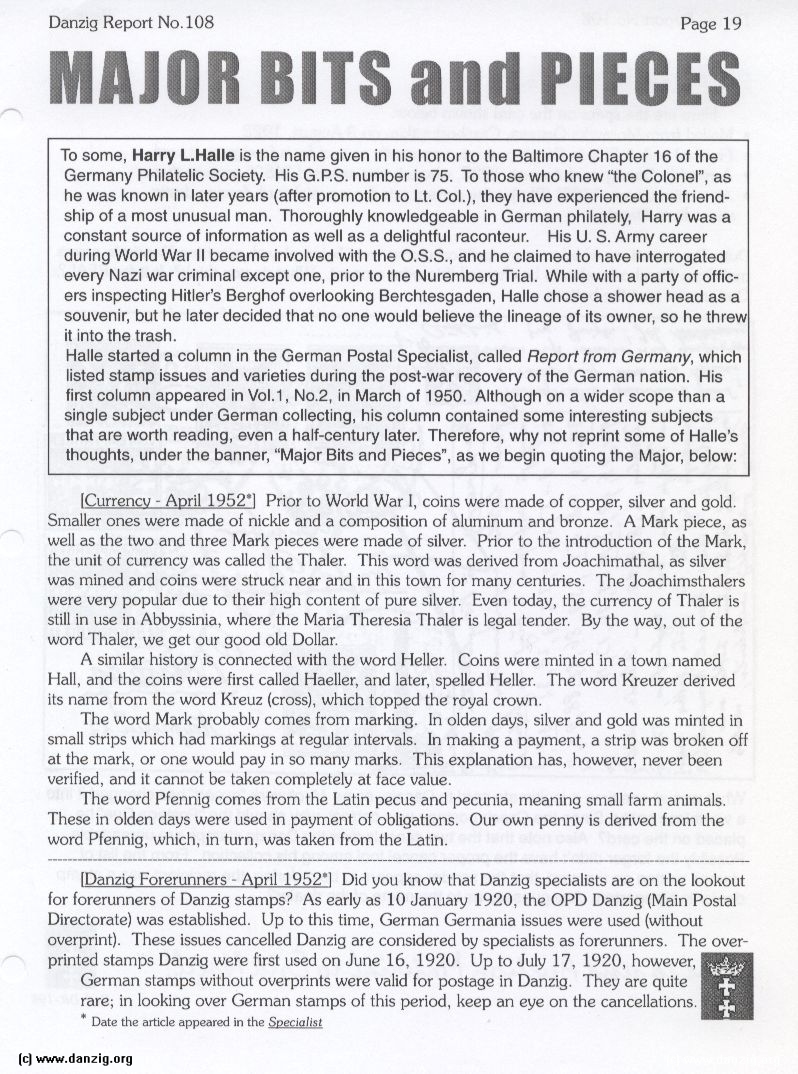
MAJOR BITS and PIECES
To some, Harry L.HalIe is the name given in his honor to the Baltimore Chapter 16 of the Germany Philatelic Society. His G.P.S. number is 75. To those who knew “the Colonel”, as he was known in later years (after promotion to LI. Col.), they have experienced the friends hip of a most unusual man. Thoroughly knowledgeable in German philately, Harry was a constant source of information as well as a delightful raconteur. His U. S. Army career during World War II became involved with the O.S.S., and he claimed to have interrogated every Nazi war criminal except one, prior to the Nuremberg Trial. While with a party of office rs inspecting Hitler’s Berghof overlooking Berchtesgaden, Halle chose a shower head as a souvenir, but he later decided that no one would believe the lineage of its owner, so he threw it into the trash.
Halle started a column in the German Postal Specialist, called Report from Germany, which listed stamp issues and varieties during the post-war recovery of the German nation. His first column appeared in Vol.1, No.2, in March of 1950 Although on a wider scope than a single subject under German collecting, his column contained some interesting subjects that are worth reading, even a half-century later. Therefore, why not reprint some of Halle’s thoughts, under the banner, “Major Bits and Pieces, as we begin quoting the Major, below:
[Currency, April 1952’] Prior to World War I, coins were made of copper, silver and gold. Smaller ones were made of fickle and a composition of aluminum and bronze. A Mark piece, as well as the two and three Mark pieces were made of silver. Prior to the introduction of the Mark, the unit of currency was called the Thaler. This word was derived from Joachimathal, as silver was mined and coins were struck near and in this town for many centuries. The Joachimsthalers were very popular due to their high content of pure silver. Even today, the currency of Thaler is still in use in Abbyssinla, where the Maria Theresia Thaler is legal tender. By the way, out of the word Thaler, we get our good old Dollar.
A similar history is connected with the word Heller. Coins were minted in a town named Hall, and the coins were first called Haeller, and later, spelled Heller. The word Kreuzer derived its name from the word Kreuz (cross), which topped the royal crown.
The word Mark probably comes from marking. In olden days, silver and gold was rTunted in small strips which had markings at regular intervals. In making a payment, a strip was broken off at the mark, or one would pay in so many marks. This explanation has, however, never been verified, and it cannot be taken completely at face value. The word Plennig comes from the Latin pecus and pecunia, meaning small farm animals. These in olden days were used in payment of obligations. Our own penny is derived from the word Pfennig, which, in turn, was taken from the Latin.
[Danzig Forerunners - April 1952] Did you know that Danzig specialists are on the lookout for forerunners of Danzig stamps? As early as 10 January 1920, the OPD Danzig (Main Postal Directorate) was established. Up to this time, German Germania issues were used (without overprint). These issues cancelled Danzig are considered by specialists as forerunners. The overp rinted stamps Danzig were first used on June 16, 1920. Up to July 17, 1920, however,
German stamps without overprints were valid for postage in Danzig. They are quite rare; in looking over German stamps of this period, keep an eye on the cancellations,
Danzig Report Vol. 1 - Nr. 108 - July - August - September - 2000, Page 22.
Hits: 3250
Added: 28/07/2015
Copyright: 2025 Danzig.org

